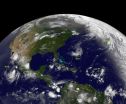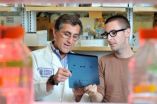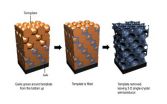(Press-News.org) It's not often that a satellite can capture an image of more than one tropical cyclone, but the GOES-13 satellite managed to get 3 tropical cyclones in two ocean basins in one image today. Bret and his "sister" Cindy are racing through the North Atlantic, while another area tries to develop far to their south. "Cousin" Dora is still a hurricane in the eastern Pacific.
In infrared image taken on July 22 at 0845 UTC (4:45 a.m. EDT), GOES-13 captured Tropical Depression Bret, Tropical Storm Cindy in the north Atlantic and low pressure area associated with a tropical wave in the Caribbean and Hurricane Dora is in the eastern Pacific, off the coast of Mexico. Cindy is 910 miles west-northwest of the Azores and Bret 295 miles northwest of Bermuda.
NASA's GOES Project issued an infrared image of both Bret and Cindy today from the GOES-13 satellite, which is operated by NOAA. The NASA GOES Project is housed at NASA's Goddard Space Flight Center in Greenbelt, Md. and uses GOES-13 data from NOAA to create images and animations.
Bret Being Battered
During the morning of July 22 Bret has sped up on his track through the north Atlantic and weakened. Bret is being battered by winds and cooler waters.
Bret was a tropical depression at 8 a.m. EDT on July 22, with maximum sustained winds near 35 mph (55 kmh). He was speeding to the northeast near 21 mph (33 kmh). By noon (EDT) Bret had degenerated into a low pressure area. His center was near 37.7N and 64.2 W, about 375 miles north of Bermuda.
Bret is now experiencing very strong wind shear and moving into cooler waters, two factors that will help dissipate the depression over the weekend. Those waters that Bret is moving into are cooler than 71 Fahrenheit (22 Celsius), about 9 degrees cooler than the threshold of warmth needed to keep a tropical cyclone going.
Tropical Storm Cindy Racing North
As Bret has sped up in his race across the Atlantic, so has his sister Cindy. Cindy is actually out-racing Bret, as she's moving to the northeast near 29 mph (46 kmh) in the far north Atlantic Ocean. She is expected to continue moving in this direction over the weekend. GOES-13 satellite data showed that her cloud pattern has become ragged overnight.
She was located about 805 miles northwest of the Azores near 44. 5 North and 39.9 West. Her maximum sustained winds were near 50 mph (85 kmh), so she's stronger than her "brother" Bret, who is now down to tropical depression status. Because Cindy is now in very cold water (68F/20C), weakening is forecast and like Bret, she could dissipate over the weekend well to the west of the British Isles.
A Tropical Wave Trying to Get Organized
Far to the south of both Bret and Cindy a low pressure area belonging to a tropical wave in the Caribbean is trying to get organized. As of July 22, the National Hurricane Center noted that there's only a 20 percent chance that the low will get its act together over the weekend.
The low pressure area is located about 425 miles east of the Windward Islands, near 15 N and 50 W, and is kicking up scattered showers and thunderstorms. It is moving almost as fast as Bret, and is headed west-northwest between 15 and 20 mph. During July 22 and 23, that low pressure area is expected to bring locally heavy rainfall and gusty winds to parts of the Lesser Antilles.
Hurricane Dora Weakening Hurricane Dora continues to weaken from northerly wind shear as it moves northwest into cooler waters as cool as 23 Celsius.
At 8 a.m. EDT on July 22, Dora has weakened to a category one hurricane on the Saffir-Simpson scale as it continues to parallel the western coast of Mexico and move in a northwesterly direction about 9 mph (15 kmh). Dora's maximum sustained winds are now near 90 mph (150 kmh). It is centered about 255 miles (415 km) south of Cabo San Lucas, Mexico near 19.2 North and 109.2 West. Minimum central pressure is 977 milibars.
There is a tropical storm warning in effect in Mexico from Agua Blanca to Buenavista including Cabo San Lucas. That means that tropical storm conditions exist somewhere in the warning area or will within 24 hours. Tropical Storm-force winds are likely in the warning area as Dora's center stays off the coast, and hurricane-force winds only extend out 35 miles from her center.
Southwestern Mexico and Baja California beaches and coastal areas will be hit with large and dangerous ocean swells. These swells will likely cause life-threatening surf and rip current conditions.
By Monday, July 25, Bret and Cindy may be off the books while Dora is expected to last through the weekend. As for the tropical wave in the Atlantic, GOES-13 will keep a close eye on it.
INFORMATION:
NASA catches 3 tropical cyclones at 1 time
2011-07-25
ELSE PRESS RELEASES FROM THIS DATE:
Northwest Forest Plan has unintended benefit – carbon sequestration
2011-07-25
CORVALLIS, Ore. – The Northwest Forest Plan enacted in 1993 was designed to conserve old-growth forests and protect species such as the northern spotted owl, but researchers conclude in a new study that it had another powerful and unintended consequence – increased carbon sequestration on public lands.
When forest harvest levels fell 82 percent on public forest lands in the years after passage of this act, they became a significant carbon "sink" for the first time in decades, absorbing much more carbon from the atmosphere than they released. At the same time, private ...
New target found for nitric oxide's attack on salmonella bacteria
2011-07-25
A new target for nitric oxide has been revealed in studies of how it inhibits the growth of Salmonella. This bacterium is a common cause of food-poisoning.
"Nitric oxide is naturally produced in the nose and the gut and other tissues in the body to ward off infection," explained the senior author of the paper, Dr. Ferric Fang. He is a University of Washington (UW) professor of laboratory medicine, microbiology and medicine.
Nitric oxide – not to be confused with nitrous oxide, the laughing gas in dentists' offices – is similar to the preservatives in hotdogs, Fang ...
2 genetic variations predict second cancers after radiation for children with Hodgkin lymphoma
2011-07-25
A genome-wide association study published in the August issue of Nature Medicine has found two tiny genetic variations that can predict which patients with Hodgkin's lymphoma are most likely to develop radiation-induced second cancers years after treatment. Knowing in advance who is at risk could help physicians tailor treatment to reduce the risks for patients who are most susceptible to long-term damage.
Hodgkin's lymphoma is one of the most treatable cancers, with more than 90 percent of patients surviving after a combination of radiation and chemotherapy. But nearly ...
Graphene's 'quantum leap' takes electronics a step closer
2011-07-25
Writing in the journal Nature Physics, the academics, who discovered the world's thinnest material at The University of Manchester in 2004, have revealed more about its electronic properties.
Research institutes and universities around the world are already looking at ways to build devices such as touch-screens, ultrafast transistors and photodetectors.
Now the research from the creators of the material promises to accelerate that research, and potentially open up countless more electronic opportunities.
The researchers, from the universities of Manchester, Madrid ...
Pocket chemistry: DNA helps glucose meters measure more than sugar
2011-07-25
CHAMPAIGN, Ill. — Glucose meters aren't just for diabetics anymore. Thanks to University of Illinois chemists, they can be used as simple, portable, inexpensive meters for a number of target molecules in blood, serum, water or food.
Chemistry professor Yi Lu and postdoctoral researcher Yu Xiang published their findings in the journal Nature Chemistry.
"The advantages of our method are high portability, low cost, wide availability and quantitative detection of a broad range of targets in medical diagnostics and environmental monitoring," Lu said. "Anyone could use it ...
New photonic crystals have both electronic and optical properties
2011-07-25
CHAMPAIGN, Ill. — In an advance that could open new avenues for solar cells, lasers, metamaterials and more, researchers at the University of Illinois have demonstrated the first optoelectronically active 3-D photonic crystal.
"We've discovered a way to change the three-dimensional structure of a well-established semiconductor material to enable new optical properties while maintaining its very attractive electrical properties," said Paul Braun, a professor of materials science and engineering and of chemistry who led the research effort.
The team published its advance ...
Epigenetic 'memory' key to nature versus nurture
2011-07-25
Researchers funded by the Biotechnology and Biological Sciences Research Council (BBSRC) at the John Innes Centre have made a discovery, reported this evening (24 July) in Nature, that explains how an organism can create a biological memory of some variable condition, such as quality of nutrition or temperature. The discovery explains the mechanism of this memory – a sort of biological switch – and how it can also be inherited by offspring.
The work was led by Professor Martin Howard and Professor Caroline Dean at the John Innes Centre, which receives strategic funding ...
Soft spheres settle in somewhat surprising structure
2011-07-25
Latex paints and drug suspensions such as insulin or amoxicillin that do not need to be shaken or stirred may be possible thanks to a new understanding of how particles separate in liquids, according to Penn State chemical engineers, who have developed a method for predicting the way colloidal components separate based on energy.
"The ongoing assumption was that if you have a mixture of different sized particles in a liquid, the faster-settling particles will end up on the bottom," said Darrell Velegol, professor of chemical engineering. "We found that in many cases it ...
Mismatch between cancer genetics counseling and testing guidelines and physician practices
2011-07-25
A new analysis has found that many doctors report that they do not appropriately offer breast and ovarian cancer counseling and testing services to their female patients. Published early online in CANCER, a peer-reviewed journal of the American Cancer Society, the study indicates that efforts are needed to encourage these services for high-risk women and discourage them for average-risk women.
Women with mutations in the BRCA1 or BRCA2 gene have a substantially increased risk of developing breast and ovarian cancer, but there are medical treatments that can dramatically ...
Children eating more, and more frequently outside the home
2011-07-25
Philadelphia, PA, July 25, 2011 – As childhood obesity rises and the American diet shifts towards increasing consumption of foods eaten or prepared outside of the home, concerns about the nutritional quality and the total consumption of such foods are also increasing. According to a study conducted at the University of North Carolina at Chapel Hill and published in the August 2011 issue of the Journal of the American Dietetic Association, eating location and food source significantly impact daily energy intake for children. Foods prepared away from home, including fast ...





